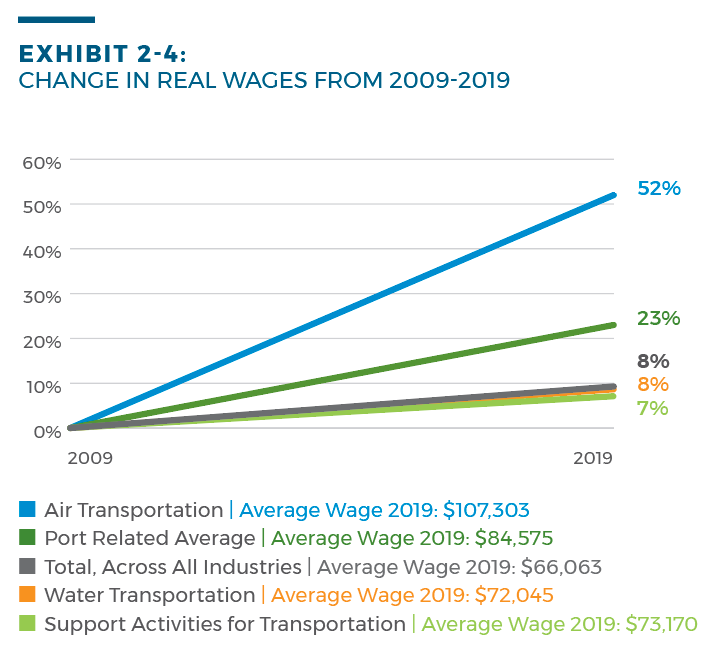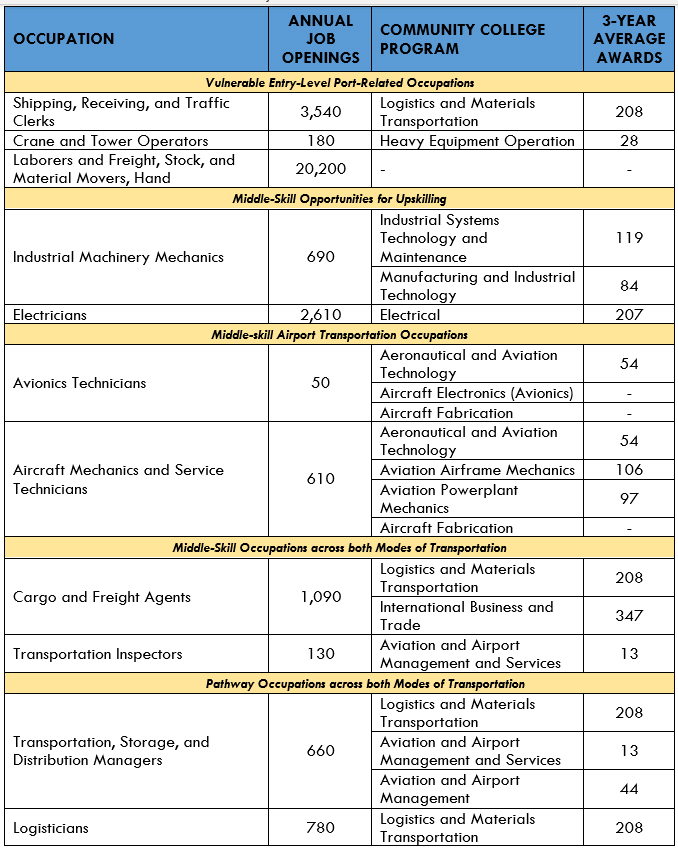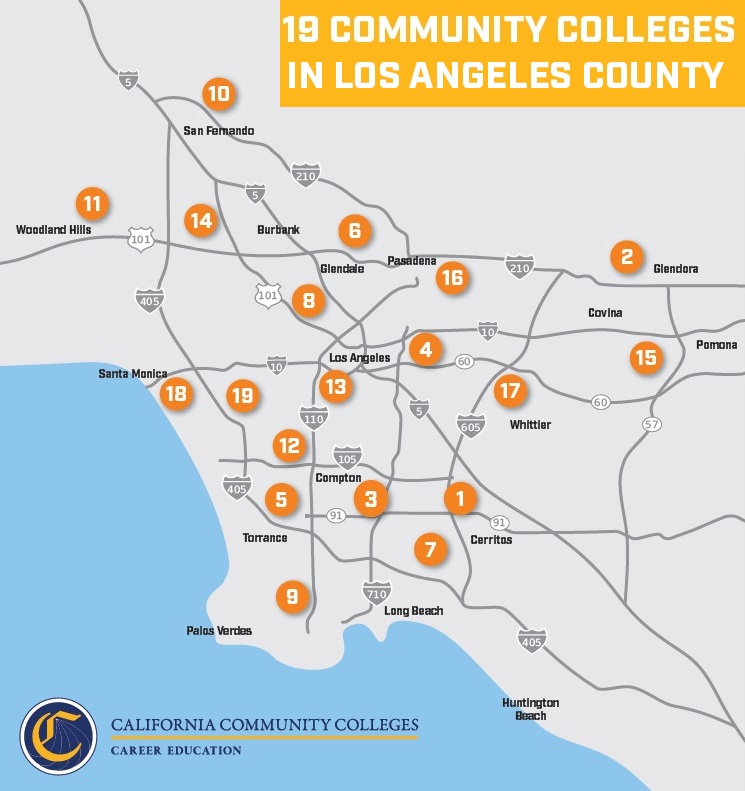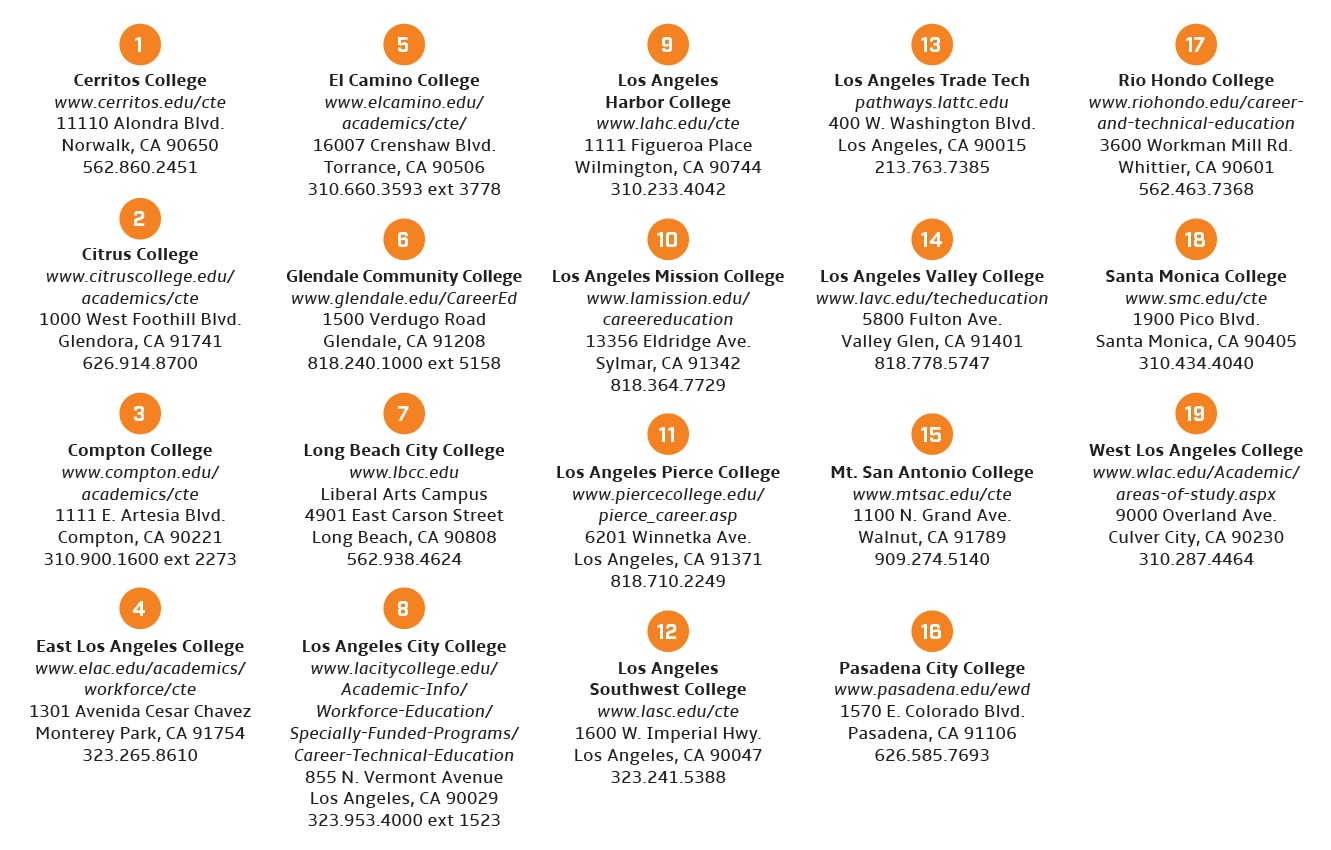Introduction
In this report CCW discusses the changing labor market at the airports and seaports of the Los Angeles County region, the supply of talent for these jobs, and the outlook for the industry including forecasts of job openings. This report is designed to help college faculty, job-seekers, students, employers at the ports, and our region’s workforce development systems.
The Los Angeles Basin’s competitive and rapidly changing economic landscape has given rise to a job market in which highly specialized knowledge and skills often mean the difference between success and failure. To help meet this challenge, the Center for a Competitive Workforce (CCW) set out to study occupations within the port-related industries of the Los Angeles Basin, with the intention of calibrating the region’s talent development system. This report is the latest in a series of reports by the Center for a Competitive Workforce, the LA/OC Center of Excellence for Labor Market Research and the Los Angeles County Economic Development Corporation.
The partnership between our region’s community colleges and industry has never been more important. LAEDC, as the region’s economic development leader, is a strategic partner facilitating regional industry engagement efforts and providing the labor market research expertise from which good planning and data-driven decisions can be made. Together, the colleges and LAEDC are leading this important regional initiative to sustain our economy and deliver opportunity for students and businesses.
CCW convenes employers/industry and community colleges to promote collaboration and share insights on talent, technology and trends to strengthen the alignment of education and training that meets the needs of the rapidly changing industries that will dominate our economic future. The center’s work addresses the talent gaps employers face and the supply of skilled talent to meet projected workforce demand. CCW was founded as a Strong Workforce Program regional project of the 19 community colleges in the Los Angeles region, the L.A./O.C. Center of Excellence for Labor Market Research (COE), and the LAEDC and its Institute of Applied Economics. CCW has several work streams:
• Labor Market Analysis • Industry Councils • Regional Program Advisory Meetings • Work-Based Learning Partnerships • Company Visits and Career Videos • Workforce and Education Partners Portal • Bioscience Industry Portal
IN THIS REPORT, CCW:
- Analyzes the major trends occurring in LA’s seaport/airport industries
- Projects regional employment in target occupations
- Identifies the jobs that have the brightest future for community college students in the region
Download Opportunities in Global Commerce: Middle-Skill Jobs at LA Basin Air and Sea Ports 6.91 MB 121 downloads
...Industry Overview
As a hub for international trade and tourism, the Los Angeles Basin places extreme importance on its transportation, warehousing and logistics sectors as economic drivers. The San Pedro Bay Ports, which include the Port of Los Angeles and the Port of Long Beach, contributed close to $370 billion alone in cargo value in the year of 2019. With the growth of electronic commerce and expedited shipping, transportation and logistics is only growing in importance.
However, there are changes on the horizon which have the potential to transform the nature of the port-related workforce. Modernization, automation and new technologies are expected to change how ports operate and create potential pathways towards greater efficiency, safety and sustainability. Meanwhile, the aging and retiring workforce will create a high number of job openings for new entrants to the workforce. The port-related industries are in a period of transition and modernization, and it is essential for the community college system to be able to provide students with the proper tools and skills to succeed in this new environment.
107K
The port-related industries employed 106,535 public and private payroll workers in the Los Angeles Basin in 2019, accounting for 1.7% of total regional employment
53%
The 53% growth rate of payroll employment has vastly outpaced that of the all-industries average in the Los Angeles Basin
91%
In the LA Basin, air transportation has seen the largest employment growth by percentage in the ports industries, with a 91% employment gain over the decade
$$$
In 2019 the average wage across the highlighted industries was $84,575, well above the average wage of $66,063 in the Los Angeles Basin
More about LA’s airport/seaport workforce
64K
Overall, 64,230 job openings will be available in port-related transportation industries in the Los Angeles Basin from 2019 to 2024
59%
Well over half (59%) of projected openings will be for middle-skill occupations, which reinforces the selection of port-related transportation industries as a valid target for community college programs
Shortage
Right now and into the future, there is a shortage of workers for ports-related jobs, meaning that job-seekers face great opportunity if they spend modest time and money to train.
Gap
The 11 occupations highlighted in this report are poised for growth based on their involvement in the supply chain, while college credential attainment from related programs remains relatively low, representing opportunity to scale training programs.
Jobs with a bright future
Middle-Skill Occupations
Traditionally, the Center for a Competitive Workforce has selected target occupations that employ mostly middle-skill workers. These middle-skill opportunities typically have educational attainment levels that are higher than a high school diploma but less than a bachelor’s degree.
This report identifies eleven occupations, which include three entry-level occupations vulnerable to displacement in the long-term and eight middle-skill and pathway occupations for workers to target.
Vulnerable Entry-Level Port-Related Occupations
These lower-skill opportunities typically have little to no requirements for educational attainment and pay lower wages. These have the highest risk of being displaced by modernization, and workers in these occupations are recommended to consider upskilling and retraining to attain more secure jobs.
- Shipping, Receiving and Traffic Clerks
- Crane and Tower Operators
- Laborers and Freight, Stock and Material Movers, Hand
Middle-Skill and Pathway Occupations
The Center for a Competitive Workforce also identified eight pathway occupations that will be attractive opportunities for community college graduates and current lower-skilled port workers to target. These occupations generally require higher than a high school education and pay above the living wage.
- Electricians
- Industrial Machinery Mechanics
- Avionics Technicians
- Aircraft Mechanics and Service Technicians
- Cargo and Freight Agents
- Transportation Inspectors
- Transportation, Distribution and Storage Managers
- Logisticians
Shipping, Receiving and Traffic Clerks
What they do:
Verify and maintain records on incoming and outgoing shipments involving inventory. Duties include verifying and recording incoming merchandise or material and arranging for the transportation of products. May prepare items for shipment
Wage: $13/hr.
5-Year Projections
520 port-related job openings
18,000 openings across all industries
Laborers & Freight, Stock & Material Movers, Hand
What they do:
Manually move freight, stock, luggage, or other materials, or perform other general labor. Includes all manual laborers not elsewhere classified.
Wage: $12/hr.
5-Year Projections
7,000 port-related job openings
101,000 openings across all industries
Industrial Machinery Mechanics
What they do:
Repair, install, adjust, or maintain industrial production and processing machinery or refinery and pipeline distribution systems. May also install, dismantle, or move machinery and heavy equipment according to plans.
Wage: $21/hr.
5-Year Projections
30 port-related job openings
3,440 openings across all industries
Transportation, Distribution & Storage Managers
What they do:
Oversee operations concerned with the storage and distribution of merchandise. They often work in warehouse situations and may also be involved with transportation.
Wage: $34/hr.
5-Year Projections
390 port-related job openings
3,280 openings across all industries
Logisticians
What they do:
Analyze and coordinate the ongoing logistical functions of a firm or organization. Responsible for the entire life cycle of a product, including acquisition, distribution, internal allocation, delivery, and final disposal of resources.
Wage: $31/hr.
5-Year Projections
310 port-related job openings
3,880 openings across all industries
Cargo & Freight Agents
What they do:
Expedite and route movement of incoming and outgoing cargo and freight shipments in airline, train, and trucking terminals and shipping docks. Take orders from customers and arrange pickup of freight and cargo for delivery to loading platform. Prepare and examine bills of lading to determine shipping charges and tariffs.
Wage: $17/hr.
5-Year Projections
4,180 port-related job openings
5,470 openings across all industries
Transportation Inspectors
What they do:
Inspect equipment or goods in connection with the safe transport of cargo or people. Includes rail transportation inspectors, such as freight inspectors, rail inspectors, and other inspectors of transportation vehicles not elsewhere classified.
Wage: $15/hr.
5-Year Projections
330 port-related job openings
670 openings across all industries
Although a substantial proportion of economic activity in Los Angeles Basin will remain disrupted until COVID-19 vaccines are widely distributed, certain sectors of the economy are projected to be a significant source of well-paying, middle-skill jobs through 2024, particularly jobs involved in the global supply chain at the Los Angeles Basin’s air and sea ports. By completing a year or two of postsecondary education, specialized training, or a transfer program, area residents can enter occupations that are in demand, pay at least a living wage, and do not require a significant investment of time or money.
Community colleges in the region offer noncredit awards, certificates, and associate degrees in many areas that provide the necessary training for the 11 target occupations in port-related transportation industries.
Challenges, Recommendations & Next Steps
Technology will be one of the greatest driving forces of evolution in transportation and warehousing, as it provides the ability to operate at higher levels of efficiency and speed with better safety. Oftentimes this will augment the capabilities of workers and allow them to perform their jobs better; however, we must also be careful to steer community college graduates and potential workforce entrants towards middle-skill and higher-skill occupations (jobs requiring more than a high school education) that will be less susceptible to displacement. Some low-skill jobs in the industry could eventually give way to robotic and full-scale automation, forcing workers to upskill or find employment in new sectors.
Another challenge present in these industries is the high replacement rate that has become common for lower-skilled, blue collar occupations. At the ports, workers employed in jobs such as freight, stock and material movers or stockers and order fillers often do not last long before transferring out of the occupation and searching for new opportunities, leading to a constant demand for labor in these positions. With a shortfall of qualified entrants into the labor market, filling vacancies has often been difficult for employers. In time, automation may be utilized by employers to solve for the high turnover issue, but in the short-term understaffed crews can lead to delays and inefficiency at a time when transportation and warehousing is expanding.
As such, a key recommendation is to engage with industry associations, such as the Pacific Maritime Association (PMA) and labor unions, such as the International Longshore and Warehouse Union or the International Brotherhood of Electrical Workers (and others), represented at the ports as much as possible in the coming months and years to ensure that modernization is implemented at the San Pedro Bay Ports in a manner that is beneficial for workers and employers, and enhances long-term job security and market competitiveness. Through a collaborative approach, these bodies can work toward a sustainable adoption of automation and technology in the port environment. Strengthening the synergy between industry associations, labor unions, and community colleges can create benefits for all sides, namely a steady supply of workers with the cutting-edge skills needed by the ports, a globally competitive operation with the ability to process cargoes and goods efficiently and effectively, and a clean and green port complex supporting good paying and stable jobs for the region.
Furthermore, as a global hub for international business and trade, the Ports of Los Angeles, Long Beach and LAX will continue to play a dominant role in the global economy. As the nation’s top-ranking customs district with over $428 billion in total two-way trade with the world and the top California destination for foreign direct investment (FDI) with over 5,113 foreign-owned establishments, Los Angeles will need more workers trained in international business and trade in the coming years. As more international companies continue to explore near-shoring options, community colleges need to equip students with the technical skills to work with international firms.
With the coming modernization, a number of below middle-skill occupations will be at risk, including the ones identified as vulnerable in this report. As a degree of displacement is likely even in the best-case scenarios, retraining and upskilling will be key for community college programs. The introduction of technology has the potential to require and create a diversity of skills and daily task requirements among workers in port-related industries, and the ability to oversee and interact with technology will become essential for success. Training community college students for the ports of the future, which are expected to become more digital, modern, efficient and environmentally conscious than ever before, will ensure there is a steady supply of qualified graduates to fill positions that are increasingly demanding higher levels of proficiency. Existing community college programs can increase their emphasis on these skills, or create new, short-term certificate programs to upskill the existing workforce, and workers displaced by the pandemic.
Providing awareness about employment opportunities is also a critical operation as shortfalls in labor supply currently exist for all four cohorts of the highlighted target occupations. It is clear that jobs are available and ready to be filled. A concerted effort in marketing the opportunities available in the growing port sector, along with the necessary certification programs or degree paths that provide qualification for these opportunities, could increase the number of entrants into applicable programs in the Los Angeles Basin. Workers who lost their jobs in industries hit hardest by the pandemic could benefit from this information, which could mobilize them to pursue promising career paths that offer stability and a living wage.
Engage with CCW
After clicking the link near the top of this page to read the full report, please explore this website. CCW works with the community colleges and industry partners, to help establish work-based learning partnerships and pathways, to enable conversations about scale and content of college programs to meet the hiring demand in industry. In addition the CCW partner portal serves as regional infrastructure to efficiently connect students and employers, so they can share job leads, work-based learning opportunities and resumes, on a Salesforce community platform.
CCW brings LA’s Industry, Talent, and Community Colleges together to be more demand‐driven, industry responsive, future‐forward and adaptive.
Start by asking a question and we are happy to point out ways you can use CCW to your advantage:
Reach out to: claire.anderson@laedc.org









